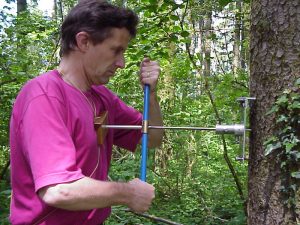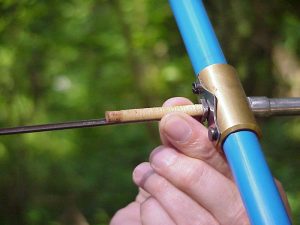Leigh Hutchison
Department of Geology
The College of Wooster
Navigation
Abstract
The biology of tree rings lends them to be effective records of climatic, geomorphological, and ecological changes in the environment. Seven cores from Northern Red Oak (Quercus rubra) and White Oak (Quercus alba) trees, located on The College of Wooster campus in Wayne Co., Ohio, were measured and crossdated. The chronology created spans from 1690 to 2000. A significant feature of the chronology is a release and an increase in growth around 1866 for the following years.
Background
Even as children we are taught that the age of a tree can be determined by counting to the number of tree rings at the lower part of the tree trunk. But, as children we may not have realized that patterns of rings can be compared among trees to determine the exact year in which rings were formed (Fritts, H.C., 1976) . Precise dating of events involving the “maiming or killing” of a tree is possible because tree growth is affected by variations in climates, and the “yearly sequence of favorable and unfavorable (wet and dry or warm and cold years) is faithfully recorded by the sequence of wide and narrow rings in large numbers of trees (Fritts, 1976). Tree rings are distinct, variable, and therefore datable.
An understanding of tree growth and wood structure is imperative for relating environmental factors to ring widths and other characteristics of the ring. The unique features of tree rings are a direct result of their formation through xylogenesis. Xylognesis, the process of wood formation, refers to the initial differentiation of the xylem and phloem from the apical meristem and the subsequent generation of xylem and phloem from the vascular cambium. In the seedling, the cells of the lower and central part of the apical meristem become the pith, the soft parenchyma tissue at the center of the stem. The cellssurrounding the pith differentiate to form the first xylem and phloem. Division of the cells between the xylem and phloem give rise to the vascular cambium tissue. Xylem are produced on the inside of the cambial layer and phloem are produced on the outside. The bark is composed of the tissues outside of the vascular cambium (Fritts, 1976). The formation of xylem and phloem each consecutive year results in rings which, depending on the environmental conditions of the growing season, may have very distinct widths or features.
Another important characteristic of wood formation is the differentiation between early and late wood, which together form a ring. Early wood is put on in the early spring at the beginning of the growing season, is relatively light in color due to larger cells with thin cell walls. The late wood is added in the summer at the end of the growing season and is characterized by small thick walled cells. This layer appears dark. In hardwoods such as oak, the early wood contains vesicles, while the late wood does not (Fritts, 1976).

Interaction between the climate during the early and late phases of the growth season and the formation of rings through xylogenesis results in the distinct widths and features of rings. Ring patterns, narrow and wide rings, which are observed in both living and fallen trees in an area can be matched, a procedure termed crossdating (Fritts, 1976). Through crossdating, exact calendar dates can be assigned to the rings and thus also to past historical and natural events. Through crossdating a post or beam of a historic structure with records of early trees in the area, the age of the beam and the structure can be determined. Similarly, through crossdating, dates can be assigned to the advance of glaciers in a certain area (dendrogeomorphology), a fire or clearing event (dendroecology), or a drought (dendroclimatology) . The dating of particular events through the analysis of tree rings and crossdating is termed dendrochronology (Fritts, 1976).
The analysis of tree ring width based on climate can be analyzed to provide information on the nature of past climate and can aid in predicting future climate. The reconstruction of past climate based on tree rings is dendroclimatology, a subfield of dendrochronology (Fritts, 1976). Reconstruction of past climate can be accomplished through “(1) comparing modern meteorological records with the widths of tree rings produced during the same period of time; (2) establishing a statistical equation for the relationship between the two; and (3) substituting the widths of the dated rings in the equation to obtain a statistical estimate of the climate for previous years” (Fritts, 1976).
Dendrogeomorphology is another subfield of dendrochronology which is the study of geomorphic processes through tree rings (Fritts, 1976). One application of this subfield is the study of trees which were run over by glaciers. With the use of dendrochronology, the date at which the glacier(s) inundated the tree(s) can be determined. Thus, the extent of glaciation for a given time and dates of the advances and retreats of glaciers can be determined based on the nature of the rings.
An additional subfield of dendrochronology, which is especially important for this study, is that of dendroecology. Dendroecology is the study of ecological processes through tree ring analysis. For example, this might include an examination of the number of release events found in the tree rings indicating how often canopy gaps were formed in the stand, or perhaps an examination of the relationship between acid precipitation and tree ring responses (McCarthy, 1997). Dendroecology may be applied with a response in tree ring width, with regard to a shift in stand dynamics, clearing resulting in canopy gaps, and land use in The College of Wooster oak study.
Oaks were chosen for The College of Wooster study not only because of their abundance on campus, but also because of their longevity. The oldest white oaks in the world are considered to be 600-800 years old (Schweingruber, 1993). Prior to the construction of the campus, this area was dominated by large stand, old growth oak forests.
The College of Wooster was founded in 1866, resulting in the clearing of large stand oak forests for the establishment of the college. Although most of the oaks were cleared, many of the original oaks remain a part of the campus. A growth release, a shift in growth rates as documented by the width of the tree rings, is expected following the establishment of the college due to a change in the stand density. With a decrease in competition for soil resources and water, and an increase in sunlight and room for growth, it is expected that the cores will reflect a growth release around 1866 followed by wider rings.
Materials
- Tree-coring equipment (borer) (Figure 3)
- Core mounting equipment (wood glue, slotted mounts, belt sander, sand paper, polishing paper)
- Dissecting microscope
- QUICK-CHEK digital measuring device
- PJK Metronics, COFECHA, KaleidaGraph, and ARSTAN computer programs


Methods
Trees were selected from the oak grove on The College of Wooster campus in Wayne Co., Ohio during the fall growing season 2001. Red and white oaks were selected to core based on their morphology. Oaks with large, yet compact trunks, thinning of and loss of bark at the base of the trunk, and trees with a slight lean were selected for sampling because these features are signs of significant age. Cores were taken from opposite sides of the tree in an attempt to capture true documentation of the trees’ rings; ideally a core perpendicular to the rings and lacking disruptive rays.
The cores were taken to the lab where they were dried and mounted following the procedure on Stokes and Smiley (1996), page 44. The cores were then sanded with a belt sander to reveal a flat surface which exposed the rings-in essence a cross-section of the core. The cores were then hand-sanded, with fine sand paper and polishing paper, to produce a glossy finish which accentuated the features of the rings.
The prepared cores taken in 2001 and the previously prepared cores taken in 1999 were dated, marking the rings with decadal marks, and measured using a dissecting microscope and a QUICK-CHEK digital counter which records measurements to the nearest 0.001 mm. Measurements were recorded in a software program called PJK Metronics.
The raw data was then run in the COFECHA program. COFECHA is a statistical program used to ensure data quality control and confirm crossdating for tree ring measurements. A spline of 32 yrs was used to remove the trends and long series from the data. The program cross dates undated series with a master list chronology and compares for best fit.
Graphical representations of each tree ring series were created using ARSTAN in order to view trends in the data. The growth trend and tree-ring indices created in ARSTAN for each core were standardized with a horizontal line through the mean. A standard series plot ring-width chronology for The College of Wooster oaks was created using the computer program KaleidaGraph. All seven cores were compiled to produce this chronology.
Results
Consistent with the expectations, six of the seven cores documented a series of narrow rings ranging from 1690 to the 1860’s and a release, followed by an increase in growth in the late 1860’s followed by wide rings until the trees’ death or the time of coring. A single core did not show the 1860’s release because its first year of measure was 1863, not providing enough pre-1866 measurements to show a significant change following the establishment of the college. The ring-width chronology for The College of Wooster oaks shows the significant increase in ring widths following the 1866 release (Figure 1).
Discussion
The plotted data reveal trends which were consistent with the expectations of an increase in rate of growth following the 1866 establishment of The College of Wooster and the clearing of trees. The increase in growth rate commencing in the late 1860’s is most likely a result of the shift in stand dynamics-a decrease in tree density as a result of clearing for the construction of The College of Wooster. With this decrease in competition among trees, and the destruction of a dense canopy, yearly growth increased. As trees were cleared an increase in sunlight was most likely a key factor in the release-“tree growth clearly responds to variations in availability of light…trees cleared by fire, storm, or forest management will in the following year produce notably wider tree rings” (Schweingruber, 1993).
Due to this dramatic increase in growth, likely to have nothing to do with climate, but rather stand dynamics, the effects of climate on the growth of these trees was not investigated. In this study the general trend depicting the increase of post 1866 growth was gleaned, however, with so few cores, it would be difficult to make statements about the yearly or decadal climatic events in this area. In order to examine the documentation of climatic events in the oaks of The College of Wooster, it is imperative that more cores be measured.
Literature Cited
- Fritts, H.C. 1976. Tree Rings and Climate. Academic Press, NY.
- McCarthy, Brian C. 1997. Department of Environment and Plant Biology, Ohio
- UniversityAthens, OH. Visited 11 December 2001.
- Environmental and Plant Biology – Ohio University
- Schweingruber, F. H. 1993. Trees and Wood in Dendrochronology. Springer-Verlag,NY.
- Stokes, Marvin A. and Terah L. Smiley. 1996. An Introduction to Tree-Ring Dating.
- The University of Arizona Press, Tucson, pp. 44.
